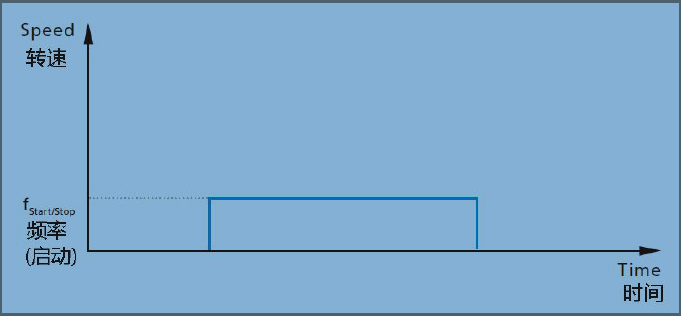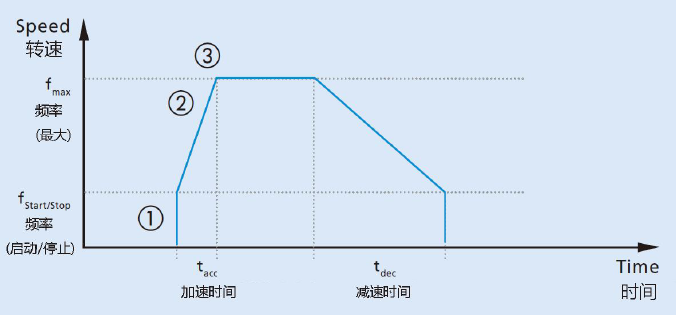①A seconda del tipo di profilo di movimento, l'analisi è diversa. Funzionamento Start-Stop: in questa modalità di funzionamento, il motore è collegato al carico e funziona a velocità costante. Il motore deve accelerare il carico (superare l'inerzia e l'attrito) entro il primo passaggio alla frequenza comandata.

Modalità di errore:Motore passo-passonon si avvia
| Motivi | Soluzioni |
| Il carico è troppo alto | Motore sbagliato, seleziona un motore più grande |
| Frequenza troppo alta | Ridurre la frequenza |
| Se il motore oscilla da sinistra a destra, una fase potrebbe essere interrotta o non collegata | Sostituire o riparare il motore |
| La corrente di fase non è appropriata | Aumentare la corrente di fase, almeno durante la prima pochi passi. |
②Modalità di accelerazione: in questo caso, ilMotore passo-passoè autorizzato ad accelerare alla frequenza massima con un tasso di accelerazione preimpostato nel driver.

Modalità di errore: il motore passo-passo non si avvia
Per ragioni esoluzionivedere ① sezione "Funzionamento Start-Stop".
Modalità di errore: il motore passo-passo non completa la rampa di accelerazione.
| Motivi | Soluzioni |
| Motore intrappolato nella frequenza di risonanza | ● Aumentare l'accelerazione per passare attraverso la risonanzafrequenza rapidamente●Seleziona la frequenza di avvio-arresto sopra il punto di risonanza●Utilizzare il mezzo passo o il micro-passo●Aggiungere uno smorzatore meccanico che può assumere la forma di undisco inerziale sull'albero posteriore |
| Impostazione errata della tensione di alimentazione o della corrente (troppo bassa) | ● Aumentare la tensione o la corrente (è consentito impostare un valore più altoper un breve periodo)●Test del motore a bassa impedenza●Utilizzare un azionamento a corrente costante (se si utilizza un azionamento a tensione costante) |
| Velocità massima troppo alta | ●Ridurre la velocità massima●Ridurre la rampa di accelerazione |
| Scarsa qualità della rampa di accelerazione dalelettronica (succede con rampe digitali) | ●Prova con un altro autista |
Modalità di errore: il motore passo-passo termina l'accelerazione ma si blocca quando viene raggiunta una velocità costante.
| Motivi | Soluzioni |
| Il motore passo-passo funziona al limite della sua capacità e stalli dovuti ad accelerazioni troppo elevate. La posizione di equilibrio è superata, causando vibrazioni e instabilità del rotore. | ● Selezionare un tasso di accelerazione inferiore o utilizzare due diversilivelli di accelerazione, alti all'inizio, più bassi verso la velocità massima●Aumentare la coppia● Aggiungere uno smorzatore meccanico sull'albero posteriore. Notare checiò aumenterà l'inerzia del rotore e potrebbe non risolvere il problemase la velocità massima è al limite del motore. ●Azionare il motore tramite micro-stepping |
3. Aumento del carico utile nel tempo
In alcuni casi, il motore funziona normalmente per un lungo periodo di tempo, ma dopo un po' perde passi. In tal caso, è probabile che il carico applicato al motore sia cambiato. Ciò può essere dovuto all'usura dei cuscinetti del motore o a un evento esterno.
Soluzioni:
● Verificare la presenza di un evento esterno: il meccanismo azionato dal motore è cambiato?
● Verificare l'usura dei cuscinetti: utilizzare cuscinetti a sfere anziché cuscinetti a manicotto sinterizzati per prolungare la durata del motore.
● Verificare se la temperatura ambiente è cambiata. La sua influenza sulla viscosità del lubrificante dei cuscinetti non è trascurabile per i micromotori. Utilizzare lubrificanti adatti all'intervallo di funzionamento. (Esempio: il lubrificante può diventare viscoso a temperature estreme o dopo un uso prolungato, il che aumenterà il carico utile)
Data di pubblicazione: 16-11-2022
